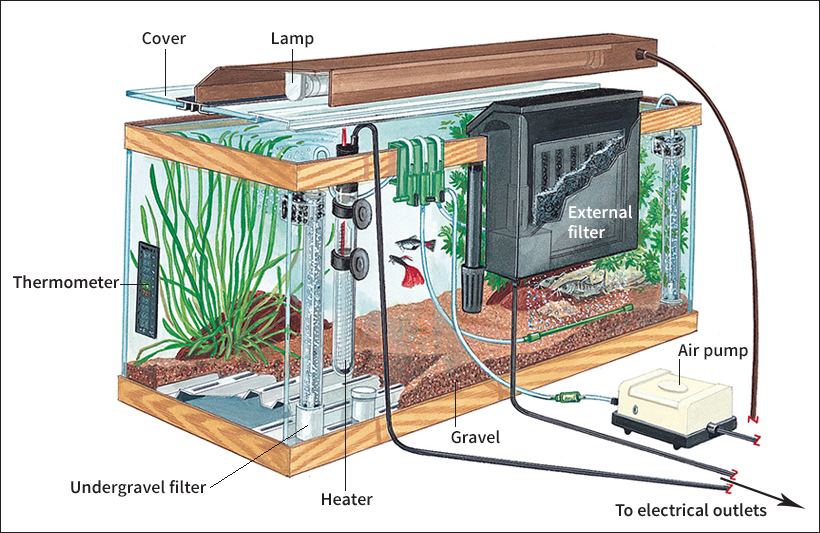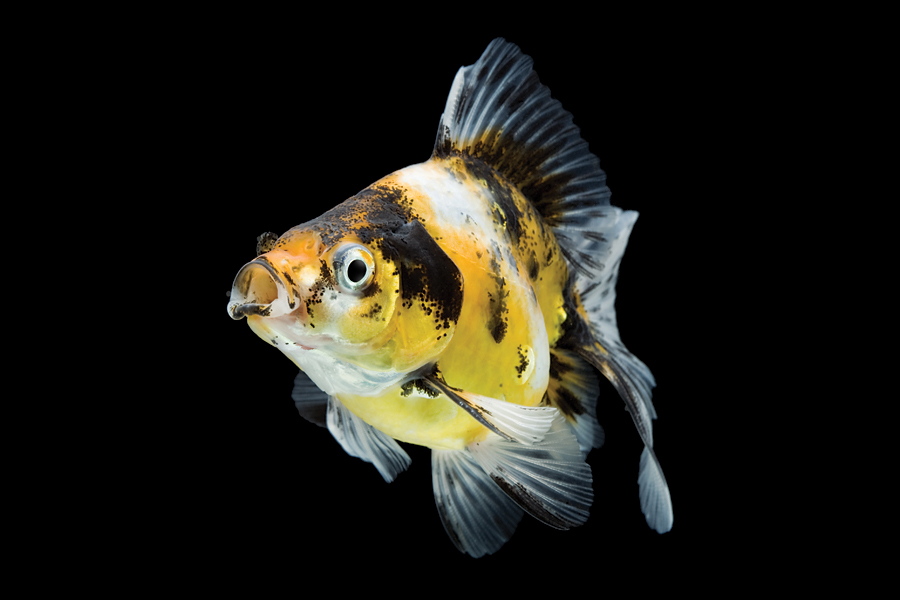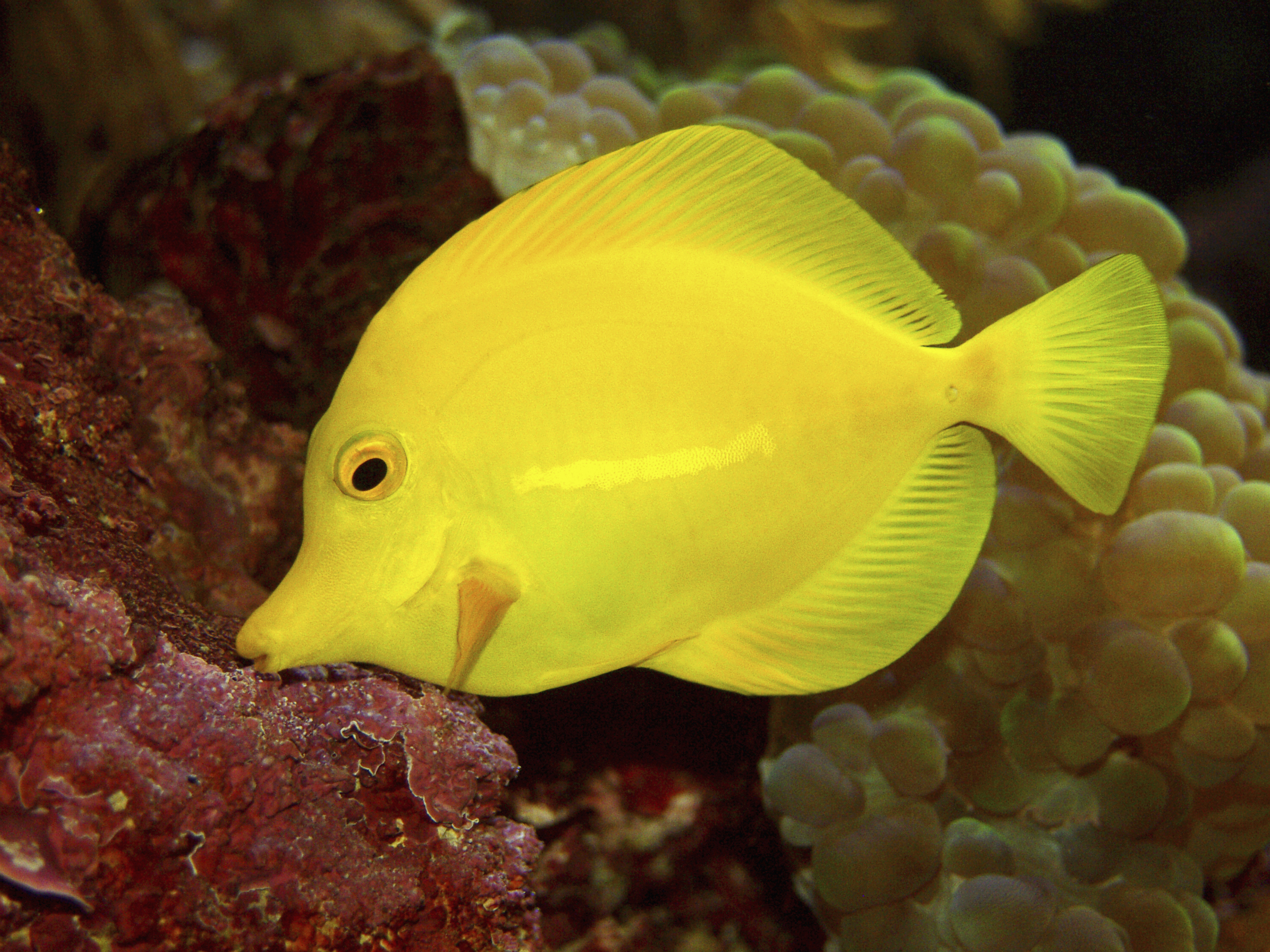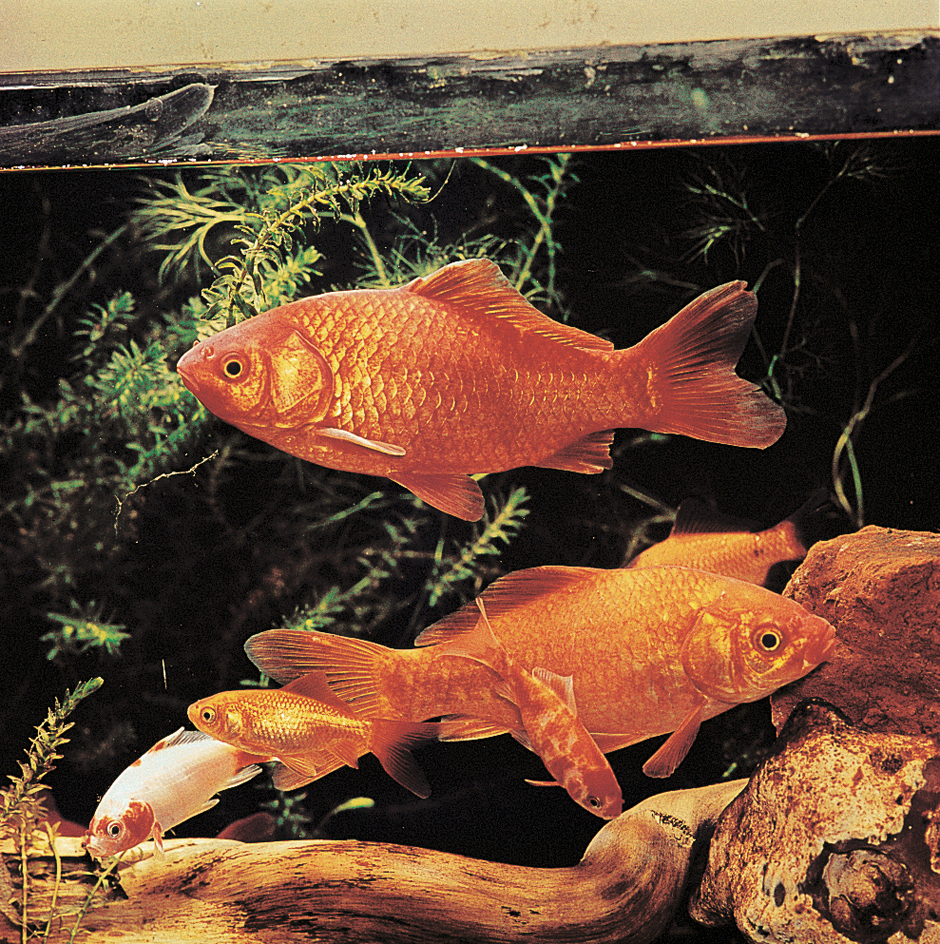Aquarium, Home, is a place where people keep their collections of fish and other water animals. Most such aquariums are in people’s homes, but some individuals have aquariums at work or other locations. The word aquarium also refers to large institutions that maintain extensive exhibits of fish and other creatures. For information on these places, see Aquarium, Public.
A person who has an aquarium is called an aquarist. Most home aquarists have freshwater aquariums rather than marine aquariums. The freshwater type requires less expense and work to set up and maintain.
Basic equipment
for a home aquarium includes (1) a tank and tank cover, (2) one or more filters, (3) a heater, and (4) a thermometer.

A rectangular tank that holds 10 to 20 gallons (38 to 76 liters) is good for a beginning aquarist. Most aquariums are made of glass and are held together with silicone sealant to make them watertight. A decorative plastic strip covers the top and bottom edges. Most tank covers include an incandescent or fluorescent lamp that shines into the tank. Such covers, called light reflectors, make it easy to see the fish. Lids that cover the entire top prevent fish from jumping out of the tank and reduce the amount of heat loss.
The aquarium filter removes dirt suspended in the water and keeps the water clean. Some filters are connected to an electrically operated air pump. The pump produces a stream of air that pushes water through the filter. An aquarium may have an external filter, an undergravel filter, or both. External filters pump the water through activated carbon, filter pads, or filter floss, which remove particles and some impurities. Undergravel filters suck potentially harmful wastes into the gravel at the bottom of the tank. Bacteria in the gravel use the wastes as food and convert them into less harmful substances.
The electric heater warms the water to the proper temperature to keep fish healthy. For most fish, the water must be kept between 72 and 80 °F (22 and 27 °C). Most heaters hang on the tank’s edge and extend into the water. Place the thermometer away from the heater where you can easily read it.
Setting up an aquarium.
After acquiring a new tank, wash the tank inside and out with lukewarm, salty water and then rinse it thoroughly. Place the tank on a level, strong surface near an electrical outlet. The aquarium should sit away from direct sunlight, drafts, and radiators. If only an external filter is used, the gravel should be rinsed and put into the tank in a layer about 1 inch (2.5 centimeters) deep. An undergravel filter should be covered with 2 to 3 inches (5 to 7.6 centimeters) of gravel.
Use tap water in your aquarium tank. Be sure to fill the tank a little at a time and to watch for leaks. When the tank is about two-thirds full, put in plants that can root in the gravel. Put the filter and heater in just before the aquarium is completely filled.
In most cases, the water should become suitable for fish two to three days after you fill the tank and start the electrical equipment. The water will look cloudy at first due to unsettled particles of dirt. Bubbles of gas may also appear. The cloudiness and bubbles will disappear in a day or two. After that time, a new cloudiness might appear, caused by bacteria. This condition should clear up in a few days.
Choosing fish and plants.
Beginners should choose hardy, inexpensive fish that do not tend to fight or chase other fish. Popular fish for beginners include angelfish, cardinal tetras, guppies, mollies, neon tetras, and platies. Place only a few fish in the tank at first. You may add more fish gradually over several weeks. The aquarist must be careful not to put too many fish in the tank. The total length of all the fish in inches should be no greater than the number of gallons in the tank.
Most aquarists begin with fish that give birth to fully formed young that are able to swim. These fish, called live-bearers, include guppies and platies. Most female live-bearers will produce young about every six weeks when the water is kept at about 75 °F (24 °C).
A live-bearer about to give birth has a bulging belly and a dark spot on the bottom of her body. Keep the fry (young fish) separate until they get big enough to live among adult fish without being eaten.
Some kinds of fish, called egglayers, hatch their young from eggs. Good egglayers for beginners include cardinal tetras, neon tetras, white clouds, and small angelfish. To breed, a female egglayer swollen with eggs should live in a separate tank with a male. Babies of egglayers are more difficult to raise than those of live-bearers. Live-bearers and egglayers can live in the same tank.

Plants make the aquarium more attractive and provide some food and shelter for the fish. They also give off oxygen, which the fish breathe, and take in carbon dioxide given off by the fish. Good aquarium plants include Elodea, which can be stuck in the gravel or floated on the surface, and Vallisneria, which takes root in the gravel. Many aquarists use lifelike plastic plants, further reducing tank maintenance.

Keeping the fish healthy.
Most aquarium fish should eat once or twice a day. At each feeding, fish should get no more than they can consume in 10 minutes. Most tropical fish will eat any good-quality commercial fish food. They also may eat live and processed brine shrimp, shellfish called Daphnia, and red worms called Tubifex. Some fish can find particles of food that have been overlooked by others, and so help clean the tank. These fish include catfish and algae eaters.

Many fish diseases can spread quickly and kill all the fish in an aquarium. Signs of illness include change of color, funguslike growths, poor appetite, slow or unusual movement, and spots. If any of these signs appear, place the affected fish in a separate tank. A tropical fish dealer can provide information on treatment.
Do not place new fish in aquarium water until they have adjusted to the water’s temperature. To help the fish adjust, float the plastic bag containing the new fish in the aquarium for 15 minutes, adding a small amount of aquarium water to the bag every 5 minutes. Some aquarists keep new fish in a separate tank for several days to check them for disease.
